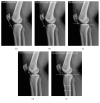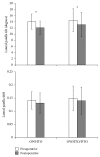Open Wedge High Tibial Osteotomy with Distal Tubercle Osteotomy Lessens Change in Patellar Position
- PMID: 28804716
- PMCID: PMC5540386
- DOI: 10.1155/2017/4636809
Open Wedge High Tibial Osteotomy with Distal Tubercle Osteotomy Lessens Change in Patellar Position
Abstract
The purpose of this study was to investigate the change in patellar position after open wedge high tibial osteotomy (OWHTO) with distal tubercle osteotomy (DTO), comparing outcomes of conventional OWHTO in young adults with proximal tibia varus deformity but no arthritic manifestations. Thirty-three patients (mean age, 31.8 years) subjected to OWHTO/DTO were matched with 30 patients (mean age, 33.5 years) undergoing conventional OWHTO. Patellar position, as measured in pre- and postoperative standing lateral radiographs, was compared. Patellar height was assessed via Insall-Salvati ratio, modified Insall-Salvati ratio, Blackburne-Peel (BP) index, Caton-Deschamps (CD) index, and modified Miura-Kawamura index. Computed tomography was used to measure lateral patellar tilt and shift. In the OWHTO group, all patellar height indices decreased significantly following surgery. Although mean values of BP and CD indices decreased significantly in the OWHTO/DTO group, other determinants of patellar height showed no significant postoperative differences. Significant postoperative declines in average lateral patellar tilt were also evident in both groups, but pre- and postoperative lateral patellar shift did not differ significantly. OWHTO/DTO can be performed without significant changes in patellar height. The results obtained support that OWHTO/DTO is suitable for relatively young patients with proximal tibia vara but no arthritic change.
Figures






Similar articles
-
Distal tibial tubercle osteotomy can lessen change in patellar height post medial opening wedge high tibial osteotomy? A systematic review and meta-analysis.J Orthop Surg Res. 2022 Jul 6;17(1):341. doi: 10.1186/s13018-022-03231-0. J Orthop Surg Res. 2022. PMID: 35794572 Free PMC article.
-
Combined tibial tubercle osteotomy with medial opening wedge high tibial osteotomy minimizes changes in patellar height: a prospective cohort study with historical controls.Am J Sports Med. 2013 Dec;41(12):2849-57. doi: 10.1177/0363546513505077. Epub 2013 Sep 27. Am J Sports Med. 2013. PMID: 24077132
-
Patellar height and tibial slope after opening-wedge proximal tibial osteotomy: a prospective study.Am J Sports Med. 2010 Jan;38(1):160-70. doi: 10.1177/0363546509342701. Epub 2009 Sep 18. Am J Sports Med. 2010. PMID: 19767536
-
Patellar Height Is Not Altered When the Knee Axis Correction Is Less than 15 Degrees and Has Good Short-Term Clinical Outcome.J Knee Surg. 2020 Jun;33(6):536-546. doi: 10.1055/s-0039-1681051. Epub 2019 Mar 15. J Knee Surg. 2020. PMID: 30877687
-
[Changes of patella position after closed and open wedge high tibial osteotomy: review of the literature].Orthopade. 2012 Mar;41(3):186, 188-94. doi: 10.1007/s00132-011-1872-9. Orthopade. 2012. PMID: 22407093 Review. German.
Cited by
-
Distal tibial tubercle osteotomy can lessen change in patellar height post medial opening wedge high tibial osteotomy? A systematic review and meta-analysis.J Orthop Surg Res. 2022 Jul 6;17(1):341. doi: 10.1186/s13018-022-03231-0. J Orthop Surg Res. 2022. PMID: 35794572 Free PMC article.
-
Distal Tibial Tuberosity Arc Osteotomy in Open-Wedge Proximal Tibial Osteotomy to Prevent Patella Infra.Arthrosc Tech. 2019 Jun 2;8(6):e655-e662. doi: 10.1016/j.eats.2019.02.011. eCollection 2019 Jun. Arthrosc Tech. 2019. PMID: 31334025 Free PMC article.
-
A Systematic Review on Selected Complications of Open-Wedge High Tibial Osteotomy from Clinical and Biomechanical Perspectives.Appl Bionics Biomech. 2021 Oct 31;2021:9974666. doi: 10.1155/2021/9974666. eCollection 2021. Appl Bionics Biomech. 2021. PMID: 34754331 Free PMC article. Review.
-
Progress in the treatment of knee osteoarthritis with high tibial osteotomy: a systematic review.Syst Rev. 2021 Feb 14;10(1):56. doi: 10.1186/s13643-021-01601-z. Syst Rev. 2021. PMID: 33583421 Free PMC article.
-
A Right Angle Guide for Distal Tuberosity Osteotomy With Medial Open Wedge High Tibial Osteotomy for Varus Knee Osteoarthritis.Arthrosc Tech. 2021 Mar 12;10(4):e1007-e1016. doi: 10.1016/j.eats.2020.11.017. eCollection 2021 Apr. Arthrosc Tech. 2021. PMID: 33981544 Free PMC article.
References
Publication types
MeSH terms
Supplementary concepts
LinkOut - more resources
Full Text Sources
Other Literature Sources

